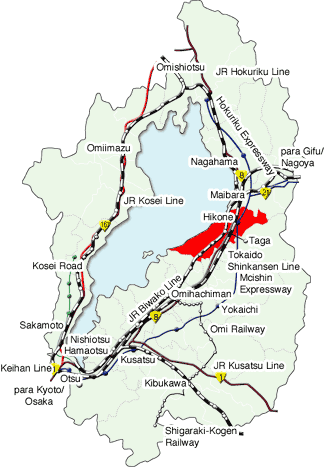Profile of Hikone

The City of Hikone is in Shiga Prefecture, near the center of Japan. Hikone lies on the eastern shore of Lake Biwa, the country's largest lake, and covers an area of 196.87 km2. Some 113,000 people live here. Distinct seasons and rich natural surroundings give Hikone an appealing year-round beauty. While serving as a center of industry and transportation, the city also attracts visitors from all Japan and overseas.
Hikone Castle, standing in elegant profile against Lake Biwa, is both the city's symbol and its main tourist attraction.
Hikone proudly maintains close sister city ties with Ann Arbor, Michigan, in the United States and Xiangtan, Hunan, in China.
Nature and Terrain
The city of Hikone sits on the Eastern shore of Lake Biwa. Wooded mountains suitable for climbing and low lying plains together create a picturesque, scenic landscape around the city. The city experiences all four seasons, which provide fun activities all year round. The spring season is filled with cherry blossoms, followed by summer when people come out to play water sports. The fall is filled with brightly colored changing leaves and cool breezes along the shoreline. In winter, many people enjoy skiing in the nearby mountains. As the seasons change throughout the year, the beautiful sunsets across Lake Biwa reamin breathtaking.
History
The City of Hikone has a very rich history. Hikone was first inhabited during the Jomon Period (10.000 years ago) and was famous for its agriculture, providing rice to the imperial court. During the shogunate era of late 16th century, Hikone served as a central battle ground for two opposing forces during a nation-wide feudal war. On September 15th, 1600, the ruling lord in Hikone, Ishida Matsunari, was defeated. The lord's castle was destroyed, and a new one was built years later in mount Koki, with support from the new Tokugawa government.
The erection of Hikone Castle resulted in the swift development of Hikone as a castle town. In 1622, the construction of the new castle and surrounding town was completed. During the Edo Period (1603 - 1867), Hikone was governed by a strict shogunate and feudal system allowing peace and prosperity for over 200 years. During this period Hikone grew and prospered with the building of major roads linking the city to the surrounding areas and a system for shipping rice to major ports on Lake Biwa.
In 1853, the American Commodore Matthew Perry led his ships to Japan causing great change for the previously secluded country. The Japanese were divided into two factions: one opposed to opening up the country, and one in favor of it. Hikone's Lord Naosuke Ii, although highly criticized at the time, signed a treaty with the U.S. that established free trade between the U.S. and Japan. He was later assasinated as a result. In 1868, the new Meiji government was established.
The end of the shogunate era brought great changes to the city of Hikone. Samurai and townsmen were forced to find new occupations and left Hikone in search of work. Hikone's population drastically decreased. However, over time, the City of Hikone adjusted to the change, and began attracting people back because of its convenient rail line, strong educational tradition, and its industrial focus.
Industry and Agriculture
Industry has flourished in Hikone since the late 1960s. During this time of economic expansion Hikone City convinced many companies to locate their factories within its area. Partly due to the ideal climate and location near Lake Biwa, which provides an adequate water resource, three main industries were established. These were the production of Butsudan (Buddhist Altars), machinery valves, and garments. This has led to newer industries such as tire production, aluminum, and electricity. In addition, agriculture in Hikone is still plentiful. Within the southern part of Hikone large rice fields can be found. Even with a decrease in the population of farmers, other areas of agriculture, such as the production of pears and green vegetables, are still developing.
Getting to Hikone
Access by Train
Types of Train (JR Line)
There are three types of train available in the JR Line:
- Local (futsuu):
Stops at every station.
- Express (shinkaisoku):
Stops at the larger cities, including Hikone.
- Bullet Train (shinkansen):
Runs between selected cities in Japan. The nearest station to Hikone is Maibara.
Coming from Tokyo/Nagoya
- Take the JR Tokaido Shinkansen to Maibara Station.
- Change trains at Maibara. You can reach Hikone by taking the JR Biwako Line, using either an express or local train.
- Hikone is approximately five minutes from Maibara.
Coming from Kyoto/Osaka
- Take the JR Biwako Line. You can reach Hikone by either express or local train, however the express train is much faster in this case.
- Hikone is approximately 50 minutes from Kyoto Station and 90 minutes from Osaka Station by express train.
Ohmi-Tetsudo Line
Connects Hikone to Echigawa, Yokaichi, Taga, etc.
Access by Car
Access to Hikone by the Meishin Express Way and national highways nº 8 (hachigo-sen) and nº 306 (san maru rokugo-sen).
City Statistics
Population: 113.027 habitants (Hikone's Prefecture - October/2019)
- Number of Men: 56.237
- Number of Women: 56.790
- Number of Households: 48.300
Area: 196.87km²
Anual Temperature (Meteorological Agency - October/2019)
- Average Temperature: 14,7 ºC
- Maximum Temperature: 31,6 ºC
- Minimum Temperature: 0,7 ºC




更新日:2024年09月02日